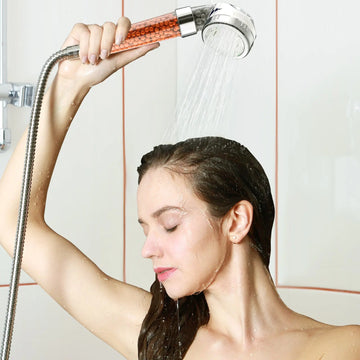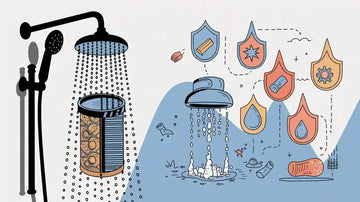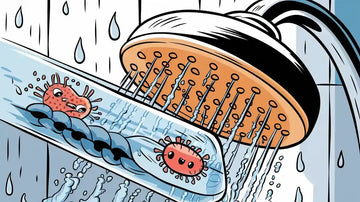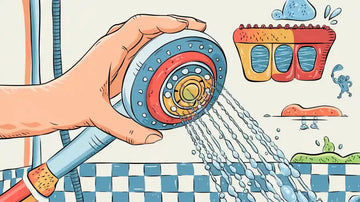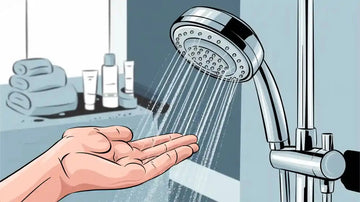Imagine walking into your shower and feeling soft water fall. It’s like standing under calm, relaxing rain. That’s what a rainfall shower head does. Unlike regular shower heads, it feels like natural rain. It gives you a spa-like experience at home. Why do people love them? First, they add a fancy touch to bathrooms. Also, their stylish look and adjustable settings fit modern designs. They’re great if you enjoy changing how your shower feels.
Key Takeaways
Rainfall shower heads give a fancy shower experience, like a spa.
They spread water evenly, helping you rinse faster without moving much.
Think about the price and setup problems since they cost more and may need expert help.
Choose ones with spray settings and water-saving features to improve showers and save water.
Clean them often and check for leaks to keep them working well and lasting longer.
Benefits of Rainfall Shower Heads
Luxurious Rainfall Shower Experience
Picture stepping into your shower and feeling soft water fall. Rain shower heads make your daily shower feel special. They turn it into a relaxing, spa-like moment. Many of these showerheads have cool features like temperature control, digital settings, and even lights.
Here’s how fancy rain shower heads compare to regular ones:
Feature |
Luxury Rainfall Shower Systems |
Conventional Shower Systems |
|---|---|---|
Multiple Showerheads |
Yes |
No |
Thermostatic Temperature Control |
Yes |
No |
Water Pressure Control |
Yes |
Limited |
Digital Controls |
Yes |
No |
LED Lighting |
Yes |
No |
Integrated Audio System |
Yes |
No |
Steam Functionality |
Yes |
No |
Built-in Shelving/Storage |
Yes |
No |
These features make showers more comfortable and fun. If you want your bathroom to feel like a retreat, a rainfall shower head is a great pick.
Wide and Even Water Coverage
Rain shower heads spread water evenly over your whole body. Unlike regular showerheads, they don’t focus water in one spot. This means you don’t have to move around to rinse off.
Their large size helps cover more area, making showers quicker and nicer. Whether you’re washing off a busy day or waking up, the smooth water flow feels amazing.
Enhances Bathroom Aesthetic
Rainfall shower heads don’t just work well—they look great too. Their modern designs can make any bathroom look stylish. You can choose from matte black, shiny chrome, or other finishes to match your taste.
Adding a rain shower head can make your bathroom look fancy. It gives your space a high-end, spa-like vibe. If you want to impress guests or enjoy a prettier home, this is a smart upgrade.
Advanced Features in Modern Rain Shower Heads
Modern rainfall shower heads are more than just good-looking. They have smart features that make showers better. These upgrades focus on comfort, saving water, and personal choices. Let’s explore some cool features in today’s rain shower heads.
Customizable Water Flow
You can change how the water feels on your skin. Many rain shower heads let you pick gentle or strong water pressure. This lets you match the shower to your mood.
Innovative Nozzle Design
The nozzles do more than spray water. They spread water evenly, like real rain. With more nozzles, water covers your body without needing to move around.
Energy and Water Efficiency
Worried about wasting water? Some rain shower heads save water with special tools. Flow restrictors and aerators use less water but keep the shower feeling nice. Air infusion mixes air with water for a full spray while saving water.
Tip: Choose low-flow rain shower heads to save money and enjoy a spa-like shower.
Multi-Spray Settings
Why stick to one spray type? Many rain shower heads offer different spray modes. You can pick mist, jet, or massage sprays for a unique shower each time.
Self-Cleaning Nozzles
Mineral buildup can block water flow over time. Self-cleaning nozzles stop clogs and keep water flowing smoothly. This means less cleaning for you.
LED Lighting for Ambiance
Some rain shower heads have LED lights for a relaxing vibe. The lights change color with water temperature, making your bathroom feel like a spa.
Here’s a quick look at advanced features in modern rain shower heads:
Feature |
Description |
|---|---|
Water Flow Control |
Pick gentle or strong water pressure for comfort. |
Nozzle Design |
Even spray covers your body without moving around. |
Flow Rate |
Adjust spray strength to match your preference. |
Internal Channeling |
Keeps water pressure steady across all nozzles. |
Water-Saving Features |
Uses tools like aerators to save water. |
Low Flow Showerheads |
Uses less water than regular models. |
Air Infusion Technology |
Mixes air with water for a full spray while saving water. |
Multi-Spray Settings |
Offers mist, jet, or massage spray options. |
Self-Cleaning Nozzles |
Stops clogs for smooth water flow. |
LED Lighting |
Adds relaxing lights that change with water temperature. |
These features aren’t just fancy—they make showers more fun and useful. Picking a rainfall shower head with these options means better comfort and less hassle.
Downsides of Rainfall Shower Heads
Higher Cost of Rainfall Shower Heads
Rainfall shower heads look fancy but can be expensive. They cost more than regular wall-mounted or handheld shower heads. Some models can cost hundreds of dollars extra. You might also need new plumbing, like a thermostatic valve, to keep water temperature steady. This adds comfort but raises the price.
If your bathroom isn’t ready for a rain shower head, you may need upgrades. These could include fixing water pressure, changing plumbing, or dealing with mold if construction reveals hidden problems. Here’s a list of possible costs:
Water pressure fixes: $300–$800
Plumbing changes: $800–$2,500
Mold removal: $500–$3,000
Electrical updates: $200–$1,500
Even cleaning up construction mess can cost extra. While rain shower heads look nice, think about these costs before buying one.
Increased Water Usage and Bills
Rain shower heads cover more area but use more water. This can make your water bills higher than usual. They spray bigger water drops, which feels nice but uses more water.
For example, regular shower heads use about 2 gallons per minute (GPM). Rain shower heads with higher flow rates can increase your monthly bill. Using more water also affects the environment. It adds to your ecological footprint, which may not fit your green goals.
To save water, look for low-flow rain shower heads. These models use less water but still feel luxurious.
Installation Challenges for Rain Shower Heads
Installing rain shower heads can be tricky. Many need to be mounted on the ceiling for the best rainfall effect. If your bathroom doesn’t have the right plumbing, you’ll need professional help.
Ceiling-mounted models often need special water lines or pumps for good pressure. Without these, the rainfall effect won’t work well. Installing them may require cutting walls or ceilings, which adds time and cost.
Even wall-mounted rain shower heads can be hard to set up. The shower arm must be long enough for water to fall straight down. If it’s too short, the water angle won’t feel relaxing.
Some rain shower heads say they’re easy to install. But it’s smart to check your bathroom setup first. This can help avoid surprises and extra costs later.
Maintenance and Cleaning of Rainfall Shower Heads
Taking care of your rainfall shower head keeps it working well. Over time, soap, grime, and minerals can block water flow. This also makes it look dirty. But don’t worry—it’s easy to clean and maintain. Follow these simple tips to keep it in great shape.
1. Regular Cleaning to Stop Build-Up
You don’t need special tools to clean your shower head. Just stay consistent.
Wipe weekly: Use a soft cloth to clean off soap and water spots. This keeps it shiny.
Soak monthly: Fill a bag with vinegar and tie it around the shower head. Let it sit for 30–60 minutes. Vinegar clears mineral buildup and unclogs nozzles.
Rinse well: After soaking, run hot water through the shower head to remove loosened dirt.
Pro Tip: If your shower head has self-cleaning nozzles, rub them gently with your fingers to clear stuck particles.
2. Deep Cleaning for Tough Dirt
If you have hard water, regular cleaning might not be enough. Here’s how to handle stubborn grime:
Take it apart: Check the manual to safely remove the shower head.
Scrub nozzles: Use an old toothbrush with vinegar or baking soda paste to scrub away dirt.
Clean the filter: Many shower heads have a small filter inside. Rinse it under water to remove debris.
Put it back together: Reassemble the shower head and test the water flow.
Note: Be gentle to avoid damaging the shower head’s finish or parts.
3. Avoiding Future Problems
Preventing issues saves time later. Try these tips to keep your shower head in top condition:
Use a water filter: Hard water causes buildup. A filter reduces this and protects your skin and hair.
Dry after use: Wipe the shower head with a dry cloth to stop water stains.
Check for leaks: Look at the connections often. Tighten loose parts to prevent water waste.
4. When to Replace Your Shower Head
Even with good care, shower heads don’t last forever. If water pressure drops, spray patterns are uneven, or clogs won’t clear, it’s time for a new one.
Good News: Modern rainfall shower heads, like the Cobbe 12 Inch All Metal Rain Shower Head, are durable and easy to maintain. With proper care, they can last for years!
Quick Maintenance Checklist
Here’s a simple checklist to keep your shower head clean:
Task |
How Often |
Tools Needed |
|---|---|---|
Wipe surface |
Weekly |
Soft cloth |
Soak in vinegar |
Monthly |
Plastic bag, vinegar |
Scrub nozzles |
As needed |
Toothbrush, baking soda |
Clean filter |
Every 3–6 months |
Running water |
Check for leaks |
Every few months |
Wrench |
By following these steps, your rainfall shower head will last longer and work better. Plus, every shower will feel as amazing as the first one. So, take a little time to care for it—you’ll be glad you did!
Tips for Picking the Best Rainfall Shower Head
Think About Your Bathroom’s Size and Layout
Your bathroom’s size affects which rain shower head works best. Big bathrooms can use fancy rain shower heads or dual setups. Medium bathrooms might need handheld options for more flexibility. Small bathrooms do well with fixed shower heads to save space.
Here’s a simple guide to match your bathroom size with the right shower head:
Bathroom Size |
Best Shower Head Type |
|---|---|
Large |
Rain shower heads or dual setups for luxury. |
Medium |
Handheld shower heads for flexibility. |
Small |
Fixed shower heads to save space. |
Also, check the height of your shower head. Rain shower heads are often placed higher than regular ones for the rainfall effect. If you want a handheld feature, make sure it adjusts to different heights. This helps everyone in your home use it easily.
Test Water Pressure Before Buying
Rain shower heads don’t always work well with low water pressure. Bigger shower heads look nice but might have weaker water flow. If you like strong showers, this is important to know.
Here’s a quick look at water pressure and cost details:
Feature |
Details |
|---|---|
Water Flow Rate |
Most use 2.5 GPM; eco models use 1.5 GPM. |
Size Impact on Pressure |
Bigger heads may lower pressure; good to check before buying. |
Standard Connection Size |
U.S. shower heads use 1/2" NPT connections. |
Check your home’s water pressure before buying. If it’s low, pick a shower head made for low pressure. Some models use air infusion to keep water flow strong while saving water.
Look at Materials and Quality
Good materials make rain shower heads last longer. Stainless steel and brass resist rust and stay strong. Plastic ones cost less but might break sooner.
To find a durable shower head, check how it’s tested. Here’s a list of common tests:
Testing Type |
Description |
|---|---|
Tests in labs check how strong and well-made it is. |
|
Home Testing |
Experts use it at home to see how it works daily. |
Full Review |
Combines lab and home tests for a full durability check. |
Also, think about the finish. Chrome, matte black, or brushed nickel look nice and protect the shower head. Adjustable spray settings add extra value and make showers more enjoyable.
Look for Adjustable Rainfall Shower Features
Not all rainfall shower heads are the same. Some come with adjustable features that let you customize your shower experience. These options can make a big difference in how much you enjoy your daily routine.
Here’s what to look for:
Adjustable Spray Modes: Many rainfall shower heads offer multiple spray settings. You can switch between a gentle mist, a powerful jet, or a soothing massage. This flexibility lets you match your shower to your mood.
Tilt and Angle Adjustments: Some models allow you to tilt or rotate the shower head. This is great if you want to direct the water flow or share the shower with people of different heights.
Handheld Attachments: A combo of a fixed rain shower head and a handheld option gives you even more control. It’s perfect for rinsing hard-to-reach areas or cleaning the shower itself.
Tip: Look for models with easy-to-use controls. A simple switch or lever makes adjusting settings quick and hassle-free.
Adjustable features make your shower more versatile and enjoyable. Whether you’re waking up or winding down, you’ll appreciate having options.
Explore Budget-Friendly Rain Shower Head Options
You don’t need to spend a fortune to enjoy the luxury of a rainfall shower head. Plenty of affordable options deliver great performance without breaking the bank.
Here’s how to find one that fits your budget:
Material Choices: Plastic models cost less than stainless steel or brass. While they may not last as long, they’re a good starting point if you’re on a tight budget.
Low-Flow Models: These save water and reduce your bills. They’re often more affordable upfront and help you save money over time.
Basic Designs: Skip the extra features like LED lights or digital controls. A simple rain shower head can still provide a relaxing experience.
Price Range |
Features You Can Expect |
|---|---|
Under $50 |
Basic plastic models with fixed spray settings. |
$50–$100 |
Mid-range options with adjustable spray modes. |
$100 and above |
Premium materials, advanced features, and combos. |
Note: Don’t forget to check for sales or discounts. You might find a high-quality shower head at a lower price.
A budget-friendly rain shower head can still transform your bathroom. It’s all about finding the right balance between cost and features.
How to Use and Maintain a Rainfall Shower Head
Proper Installation for Optimal Performance
Installing a rainfall shower head correctly ensures you get the best experience every time you step into the shower. Follow these steps to set it up like a pro:
Choose the Right Shower Head: Pick one that fits your bathroom’s size and layout. Make sure the shower arm is long enough for the rainfall effect.
Gather Supplies: Have tools like a wrench, plumber’s tape, and a soft cloth ready. Cover the drain to prevent losing small parts.
Uninstall the Old Shower Head: Use pliers or a wrench to carefully remove the existing head.
Apply Plumber’s Tape: Wrap the threads of the new shower head with plumber’s tape to prevent leaks.
Install the New Shower Head: Tighten it securely but avoid over-tightening, which could damage the threads.
Test for Leaks: Turn on the water and check for any drips. Adjust as needed.
Add Finishing Touches: If your model includes an escutcheon, install it to protect the wall and complete the look.
Tip: If you’re unsure about plumbing or drilling, consider hiring a professional plumber. This ensures proper installation and avoids warranty issues.
Regular Cleaning to Prevent Build-Up
Keeping your rainfall shower head clean is key to maintaining its performance. Over time, mineral deposits and soap scum can clog the nozzles, reducing water flow. Here’s how you can keep it spotless:
Weekly Wipe-Down: Use a damp cloth to remove water spots and soap residue.
Monthly Vinegar Soak: Fill a plastic bag with vinegar, tie it around the shower head, and let it sit for an hour. This dissolves mineral buildup.
Rinse Thoroughly: After soaking, run hot water through the shower head to flush out any loosened debris.
Pro Tip: If your shower head has self-cleaning nozzles, gently rub them with your fingers to clear any blockages.
Maximizing the Lifespan of Your Rain Shower Head
A little care goes a long way in extending the life of your rainfall shower head. Here’s how you can keep it in top shape:
Inspect Regularly: Check for leaks or loose connections every few months. Tighten any parts as needed.
Use a Water Filter: Hard water can cause mineral buildup. A filter reduces this and protects both your shower head and your skin.
Dry After Use: Wipe the shower head with a dry cloth to prevent water stains and corrosion.
Replace Parts When Needed: Some components, like O-rings or filters, may wear out over time. Replacing them promptly ensures optimal performance.
Note: Even with proper care, shower heads don’t last forever. If you notice uneven spray patterns or persistent clogs, it might be time for a replacement.
By following these tips, you’ll enjoy a refreshing rainfall experience for years to come. A little maintenance now saves you from bigger headaches later!
Rain shower heads make your showers feel fancy and relaxing. They spread water evenly, have cool features, and look stylish. But they can cost more, use extra water, and be harder to install. Here’s a simple list of the good and bad:
Pros of Rain Shower Heads |
Cons of Rain Shower Heads |
|---|---|
Feels Like a Spa |
Harder to Install |
Covers More Area |
Uses More Water |
Looks Modern |
May Have Weak Pressure |
Adjustable Settings |
Costs More |
Easier to Clean |
Needs More Space |
Before buying one, think about your bathroom size, water pressure, and budget. A recent study shows that spray strength and water temperature are key to happiness:
Performance Factor |
Why It Matters |
|---|---|
Spray Strength |
Makes showers feel better and more enjoyable |
Water Temperature |
Adds to comfort and relaxation |
Water Spread |
Improves how well the shower works |
Flow Rate |
Doesn’t always mean it saves water |
User Opinions |
Show people care more about how it works than saving water |
In the end, pick what fits your needs best. Whether you want luxury, to save money, or both, choosing carefully means you’ll love your rain shower head for a long time.
FAQ
How is a rainfall shower head different from a regular one?
Rainfall shower heads spread water gently, like soft rain. Regular ones spray water in one spot. Rain shower heads feel fancy, while regular ones are simpler.
Can I put in a rainfall shower head myself?
Yes, many are easy to install on your own. You’ll need tools like a wrench and plumber’s tape. If plumbing changes are needed, it’s best to call a pro.
Do rainfall shower heads use more water?
Some do, but low-flow models help save water. These mix air with water to feel nice but use less. Check the GPM rating to pick the right one.
Can small bathrooms have rainfall shower heads?
Yes! Wall-mounted or smaller designs fit well in tight spaces. Adjustable features make them comfy without taking up much room.
How do I keep a rainfall shower head clean?
Wipe it weekly with a damp cloth to remove spots. Soak it in vinegar once a month to clear buildup. For tough clogs, scrub with a toothbrush and baking soda. Self-cleaning nozzles make this easier.
